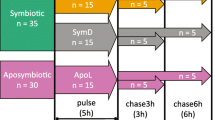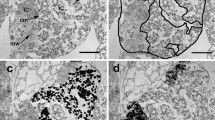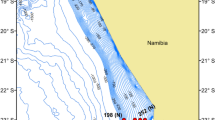Abstract
The anemone–anemonefish association is the quintessential symbol of a symbiotic mutualism from the Indo-Pacific waters. Both historical field documentation and extant scientific research advocate that these interactions are fundamental at the level of nutrient exchanges and evolutionary driving forces (natural selection) to facilitate this mutualism. Through the use of 15N and 13C stable isotope tracers, complementary laboratory- and field-based experiments were implemented in the Philippines to investigate the possibility of nutrient transmission from the host anemone, Heteractis crispa and/or endosymbiotic zooxanthellae, to two species of exosymbiotic anemonefishes (Amphiprion clarkii and A. perideraion). Mass spectrometry analyses suggest that 15N and 13C concentrations were significantly higher in tissues of the anemonefishes (intestines, liver, gills, and gonads), anemone host, and zooxanthellae compared with controls. We interpret the presence of 15N and 13C in the anemonefish tissues as direct empirical evidence for the transmission of nitrogen and/or carbon from host anemone and endosymbiotic zooxanthellae to resident anemonefish. These “translocations” and resultant recycling of elements within this classical tripartite relationship highlight the fundamental role of nutrient dynamics in this synergistic symbiosis.













Similar content being viewed by others
References
Agostini A, Suzuki Y, Higuchi T, Casareto BE, Nakano Y, Hidaka M, Badrun N (2009) Coral symbiotic complex: hypothesis through vitamin B12 for a new evaluation. J Coral Reef Studies 11:1–11. doi:10.3755/galaxea.11.1
Agostini A, Suzuki Y, Higuchi T, Casareto BE, Yoshinaga K, Nakano Y, Fujimura H (2012) Biological and chemical characteristics of the coral gastric activity. Coral Reefs 31:147–156. doi:10.1007/s00338-011-0831-6
Al-Moghrabi S, Goiran C, Allemand D, Speziale N, Jaubert J (1996) Inorganic carbon uptake for photosynthesis by the symbiotic coral/dinoflagellates association II. Mechanisms for bicarbonate uptake. J Exp Mar Biol Ecol 199:227–248. doi:10.1016/0022-0981(95)00202-2
Ambariyanto A, Hoegh-Guldberg O (1999) Net uptake of dissolved free amino acids by the giant clam Tridacna maxima: alternative sources of energy and nitrogen? Coral Reefs 18:91–96. doi:10.1007/s003380050161
Anderluh G, Sepcic K, Turk T, Macek P (2011) Cytolytic proteins from cnidarians: an overview. Acta Chim Slov 58:724–729
Arnal C, Morand S (2001) Importance of ectoparasites and mucus in cleaning interactions in the Mediterranean cleaner wrasse Symphodus melanocercus. Mar Biol 138:777–784. doi:10.1007/s002270000494
Arvedlund M, Takemura A (2005) Long-term observation in situ of the anemonefish Amphiprion clarkii (Bennett) in association with a soft coral. Coral Reefs 24:698. doi:10.1007/s00338-005-0007-3
Balamurugan J, Ajith Kumar TT, Kannan R, Pradeep HD (2014) Acclimation behaviour and bio-chemical changes during anemonefish (Amphiprion sebae) and sea anemone (Stichodactyla haddoni) symbiosis. Symbiosis 64:127–138. doi:10.1007/s13199-014-0310-2
Barneah O, Brickner I, Hooge M, Weis VM, LaJeunesse TC, Benayahu Y (2007) Three party symbiosis: acoelomorph worms, corals, and unicellular algal symbionts in Eilat (Red Sea). Mar Biol 151:1215–1223. doi:10.1007/s00227-006-0563-2
Benson AA, Muscatine L (1974) Wax in coral mucus: energy transfer from corals to reef fishes. Limnol Oceanogr 19:810–814. doi:10.4319/lo.1974.19.5.0810
Bronstein JL (2001) The costs of mutualism. Am Zool 41:825–839. doi:10.1093/icb/41.4.825
Bythell JC, Wild C (2011) Biology and ecology of coral mucus release. J Exp Mar Biol Ecol 408:88–93. doi:10.1016/j.jembe.2011.07.028
Cleveland A (1999) Energetic costs of agonistic behavior in two herbivorous damselfishes (Stegastes). Copeia 4:857–867. doi:10.2307/1447962
Cleveland A, Montgomery WL (2003) Gut characteristics and assimilation efficiencies in two species of herbivorous damselfishes (Pomacentridae: Stegastes dosopunicans and S. planifrons). Mar Biol 142:35–44. doi:10.1007/s00227-002-0916-4
Cleveland A, Verde EA, Lee RW (2011) Nutritional exchange in a tropical tripartite symbiosis: direct evidence for the transfer of nutrients from anemonefish to host anemone and zooxanthellae. Mar Biol 158:589–602. doi:10.1007/s00227-010-1583-5
Collingwood C (1868) Note on the existence of gigantic sea-anemones in the China Sea, containing within them quasi-parasitic fish. Ann Mag Nat Hist (J Nat Hist) 1:31–33. doi:10.1080/00222936808695633
Cook CB, Muller-Parker G, D’Elia CF (1992) Ammonium enhancement of dark carbon fixation and nitrogen limitation in symbiotic zooxanthellae: effects of feeding and starvation of the sea anemone Aiptasia pallida. Limnol Oceanogr 37:131–139. doi:10.4319/lo.1992.37.1.0131
Cook CB, Muller-Parker G, Orlandini CD (1994) Ammonium enhancement of dark carbon fixation and nitrogen limitation in zooxanthellae symbiotic with the reef corals Madracis mirabilis and Montastrea annularis. Mar Biol 118:157–165. doi:10.1007/BF00699230
D’Ambra I, Graham WM, Carmichael RH, Hernandez FJ Jr (2015) Fish rely on scyphozoan hosts as a primary food source: evidence from stable isotope analysis. Mar Biol 162:247–252. doi:10.1007/s00227-014-2569-5
Daumas R, Galois R, Thomassin BA (1981) Biochemical composition of soft and hard coral mucus on a New Caledonian lagoonal reef. In: Proceedings of the 4th international coral reef symposium, Manila, Philippines vol 2, pp 59–67
Davy SK, Allemand D, Weis VM (2012) Cell biology of cnidarian-dinoflagellate symbiosis. Microbiol Mol Biol R 76:229–261. doi:10.1128/MMBR.05014-11
De Crespigny CC (1869) Notes on the friendship existing between the malacopterygian fish Premnas biaculeatus and the Actinia crassicornis. J Zool 37:248–249
DeFreese DE, Clark KB (1991) Transepidermal uptake of dissolved free amino acids from seawater by three sacoglossan opisthobranchs. J Mollus Stud 57:65–74. doi:10.1093/mollus/57.Supplement_Part_4.65
Eibl-Eibesfeldt I (1960) Beobachtungen und Versuche an Anemonenfishchen (Amphiprion) der Malediven und der Nicobaren. Z Tierpsychol 17(1):1–10
Elliot DG (2000) Integumentary system. In: Ostrander GK (ed) The laboratory fish. Academic Press, San Diego, pp 95–108, 271–306
Elliott J (1992) The role of sea anemones as refuges and feeding habitats for the temperate fish Oxylebius pictus. Environ Biol Fish 35:381–400. doi:10.1007/BF00004991
Fautin DG (1991) The anemonefish symbiosis: What is known and what is not. Symbiosis 10:23–46
Fautin DG, Allen GR (1997) Field guide to anemonefish and their host sea anemones. Western Australian Museum, Perth
Fautin DG, Guo C-C, Hwang J-S (1995) Costs and benefits of the symbiosis between the anemoneshrimp Periclimenes brevicarpalis and its host Entacmaea quadricolor. Mar Ecol Prog Ser 129:77–84. doi:10.3354/meps129077
Ferguson JC (1982) A comparative study of the net metabolic benefits derived from the uptake and release of free amino acids by marine invertebrates. Biol Bull 162:1–17
Fiore CL, Jarett JK, Olson NK, Lesser MP (2010) Nitrogen fixation and nitrogen transformations in marine symbioses. Trends Microbiol 18:455–463. doi:10.1016/j.tim/2010.07.001
Fitzgerald LM, Szmant AM (1997) Biosynthesis of ‘essential’ amino acids by scleractinian corals. Biochem J 322:213–221. doi:10.1042/bj3220213
Frazao B, Vasconcelos V, Antunes A (2012) Sea anemone (Cnidaria, Anthozoa, Actinaria) toxins: an overview. Mar Drugs 10:1812–1851. doi:10.3390/md10081812
Furla P, Benazet-Tambutte S, Jaubert J, Allemand D (1998a) Diffusional permeability of dissolved inorganic carbon through the isolated oral epithelial layers of the sea anemone, Anemonia viridis. J Exp Mar Biol Ecol 221:71–88. doi:10.1016/S0022-0981(97)00116-0
Furla P, Benazet-Tambutte S, Jaubert J, Allemand D (1998b) Functional polarity of the tentacle of the sea anemone Anemonia viridis: role in inorganic carbon acquisition. Am J Physiol Regul Integr Comp Physiol 274:R303–R310
Furla P, Galgani I, Durand I, Allemand D (2000a) Sources and mechanisms of inorganic carbon transport for coral calcification and photosynthesis. J Exp Biol 203:3445–3457
Furla P, Orsenigo MN, Allemand D (2000b) Involvement of H+-ATPase and carbonic anhydrase in inorganic carbon absorption for endosymbiotic photosynthesis. Am J Physiol Regul Integr Comp Physiol 278:R870–R881
Galetto MJ, Bellwood DR (1994) Digestion of algae by Stegastes nigricans and Amphiprion akindynos (Pisces: Pomacentridae), with an evaluation of methods used in digestability studies. J Fish Biol 44:415–428. doi:10.1111/j.1095-8649.1994.tb01222.x
Godwin J, Fautin DG (1992) Defense of host actinians by anemonefishes. Copeia 1992:902–908. doi:10.2307/1446171
Gohar HAF (1934) Partnership between fish and anemones. Nature 134:291
Gohar HAF (1948) Commensalism between fish and anemone (with a description of the eggs of Amphiprion bicinctus Rüppell). Publs Mar Biol Stn Ghardaqa 6:35–44
Goiran C, Shine R (2014) Reaction of a sea snake (Hydrophis major) to contact with a sea anemone. Coral Reefs 33:793. doi:10.1007/s00338-014-1161-2
Goiran C, Al-Moghrabi S, Allemand D, Jaubert J (1996) Inorganic carbon uptake for photosynthesis by the symbiotic coral/dinoflagellates association I. photosynthetic performances of symbionts and dependence on sea water bicarbonate. J Exp Mar Biol Ecol 199:207–225. doi:10.1016/0022-0981(95)00201-4
Goiran C, Dubey S, Shine R (2013) Effects of season, sex and body size on the feeding ecology of turtle-headed sea snake (Emydocephalus annulatus) on Indo-Pacific inshore coral reefs. Coral Reefs 32:527–538. doi:10.1007/s00338-012-1008-7
Goldshmid R, Holzman R, Weihs D, Genin A (2004) Aeration of corals by sleep-swimming fish. Limnol Oceangr 49(5):1832–1839. doi:10.4319/lo.2004.49.5.1832
Gomme J (1982) Epidermal nutrient absorption in marine invertebrates: a comparative analysis. Am Zool 22:691–708. http://www.jstor.org/stable/3882589
Gorlick DL (1980) Ingestion of host fish surface mucus by the Hawaiian cleaning wrasse, Labroides phthirophagus (Labridae), and its effect on host species preference. Copeia 1980:863–868. doi:10.2307/1444466
Hattori A (2000) Social and mating systems of the protandrous anemonefish Amphiprion perideraion under the influence of a larger congener. Austral Ecol 25:187–192. doi:10.1046/j.1442-9993.2000.01035.x
Herndl GJ, Velimirov B (1986) Role of bacteria in the gastral cavity of anthozoa. Actes de Colloques 3:407–414. http://archimer.ifremer.fr/doc/1984/acte-989.pdf
Herre AWCT (1936) Some habits of Amphiprion in relation to sea anemones. Copeia 1936:167–168. doi:10.2307/1435828
Hill R, Scott A (2012) The influence of irradiance on the severity of thermal bleaching in sea anemones that host anemonefish. Coral Reefs 31:273–284. doi:10.1007/s00338-011-0848-x
Holbrook SJ, Schmitt RJ (2005) Growth, reproduction and survival of a tropical sea anemone (Actinaria): benefits of hosting anemonefish. Coral Reefs 24:67–73. doi:10.1007/s00338-004-0432-8
Koenig O (1960) Verhaltensuntersuchungen an Anemonenenfishen. Pyramide 8(2):52–56
Kopp C, Domart-Coulon I, Escrig S, Humbel BM, Hignette M, Meibom A (2015) Subcellular investigation of photosynthesis-driven carbon assimilation in the symbiotic reef coral Pocillopora damicornis. mBio 6(1):2–14. doi:10.1128/mBio.02299-14
Lesser MP, Falcon LI, Rodriguez-Roman A, Enriquez S, Hoegh-Guldberg O, Iglesias-Prieto R (2007) Nitrogen fixation by symbiotic cyanobacteria provides a source of nitrogen for the scleractinian coral Montastraea cavernosa. Mar Ecol Prog Ser 346:143–152. doi:10.3354/meps07008
Liberman T, Genin A, Loya Y (1995) Effects on growth and reproduction of the coral Stylophora pistillata by the mutualistic damselfish Dascyllus marginatus. Mar Biol 121:741–746. doi:10.1007/BF00349310
Madduppa HH, Juterzenka KV, Syakir M, Kochzius M (2014) Socio-economy of marine ornamental fishery and its impact on the population structure of the clown anemonefish Amphiprion ocellaris and its host anemones in Spermonde Archipelago, Indonesia. Ocean Coast Manage 100:41–50. doi:10.1016/j.ocecoaman.2014.07.013
Mariscal RN (1970) The nature of the symbiosis between Indo-Pacific anemone fishes and sea anemones. Mar Biol 6:58–65. doi:10.1007/BF00352608
Marubini F, Davies PS (1996) Nitrate increases zooxanthellae population density and reduces skeletogenesis in corals. Mar Biol 127:319–328. doi:10.1007/BF00942117
McCormick MI (2003) Consumption of coral propagules after mass spawning enhances larval quality of damselfish through maternal effects. Oecologia 136:37–45. doi:10.1007/s00442-003-1247-y
Meyer JL, Schultz ET (1985) Tissue condition and growth rate of corals associated with schooling fish. Limnol Oceanogr 30:157–166. doi:10.4319/lo.1985.30.1.0157
Meyer JL, Schultz ET, Helfman GS (1983) Fish schools: an asset to corals. Science 220:1047–1049. doi:10.1126/science.220.4601.1047
Moser J (1931) Beobachtungen über die Symbiose von Amphiprion percula mit Aktinien. Sber Ges naturf Freunde Berl 1931(2):160–167
Moyer JT, Bell LJ (1976) Reproductive behavior of the anemonefish Amphiprion clarkii at Miyake-Jima, Japan. Jpn J Ichthyol 23:23–32
Naumann MS, Mayr C, Struck U, Wild C (2010) Coral mucus stable isotope composition and labeling: experimental evidence for mucus uptake by epizoic acoelomorph worms. Mar Biol 157:2521–2531. doi:10.1007/s00338-010-0612-7
Nedosyko AM, Young JE, Edwards JW, Burke da Silva K (2014) Searching for a toxic key to unlock the mystery of anemonefish and anemone symbiosis. PLoS ONE 9:e98449. doi:10.1371/journal.pone.0098449
Olsen KR (2000) Circulatory System. In: Ostrander GK (ed) The laboratory fish. Academic Press, San Diego, pp 161–171
Palincsar EE, Jones WR, Palincsar JS, Glogowski MA, Mastro JL (1989) Bacterial aggregates within the epidermis of the sea anemone Aiptasia pallida. Biol Bull 177:130–140. doi:10.2307/1541840
Piniak GA, Lipschultz F (2004) Effects of nutritional history on nitrogen assimilation in congeneric temperate and tropical scleractinian corals. Mar Biol 145:1085–1096. doi:10.1007/s00227-004-1410-y
Piniak GA, Lipschultz F, McClelland J (2003) Assimilation and partitioning of prey nitrogen within two anthozoans and their endosymbiotic zooxanthellae. Mar Ecol Prog Ser 262:125–136. doi:10.3354/meps262125
Porat D, Chadwick-Furman NE (2004) Effects of anemonefish on giant sea anemones: expansion behavior, growth, and survival. Hydrobiologia 530(531):513–520. doi:10.1007/s10750-004-2688-y
Porat D, Chadwick-Furman NE (2005) Effects of anemonefish on giant sea anemones: ammonium uptake, zooxanthellae content and tissue regeneration. Mar Fresh Beh Phys 38:43–51. doi:10.1080/10236240500057929
Pratchett MS, Gust N, Goby G, Klanten SO (2001) Consumption of coral propagules represents a significant trophic link between corals and reef fish. Coral Reefs 20:13–17. doi:10.1007/s003380000113
Raina J-B, Tapiolas D, Willis BL, Bourne DG (2009) Coral-associated bacteria and their role in the biogeochemical cycling of sulfur. Appl Environ Microbiol 75:3492–3501. doi:10.1128/AEM.02567-08
Randall JE, Fautin DG (2002) Fishes other than anemonefishes that associate with sea anemones. Coral Reefs 21:188–190. doi:10.1007/s00338-002-0234-9
Rinkevich B, Wolodarsky Z, Loya Y (1991) Coral-crab association: a compact domain of a multilevel trophic system. Hydrobiologia 216–217:279–284. doi:10.1007/BF00026475
Roberts JM, Davies PS, Fixter LM, Preston T (1999) Primary site and initial products of ammonium assimilation in the symbiotic sea anemone Anemonia viridis. Mar Biol 135:223–236. doi:10.1007/s002270050620
Roberts CM, McClean CJ, Veron JEN, Hawkins JP, Allen GR, McAllister DE, Mittermeier CG, Schueler FW, Spalding M, Wells F, Vynne C, Werner TB (2002) Marine biodiversity hotspots and conservation priorities for tropical reefs. Science 295:1280–1284. doi:10.1126/science.1067728
Robertson DR (1984) Cohabitation of competing territorial damselfishes on a Caribbean coral reef. Ecology 65:1121–1135. doi:10.2307/1938320
Roopin M, Chadwick NE (2009) Benefits to host sea anemones from ammonia contributions of resident anemonefish. J Exp Mar Biol Ecol 370:27–34. doi:10.1016/j.jembe.2008.11.006
Roopin M, Henry RP, Chadwick NE (2008) Nutrient transfer in a marine mutualism: patterns of ammonia excretion by anemonefish and uptake by giant sea anemones. Mar Biol 154:547–556. doi:10.1007/s00227-008-0948-5
Roopin M, Thornhill DJ, Santos SR, Chadwick NE (2011) Ammonia flux, physiological parameters, and Symbiodinium diversity in the anemonefish symbiosis on Red Sea coral reefs. Symbiosis 53:63–74. doi:10.1007/s13199-011-0110-x
Ross RM (1978) Behavior of the anemonefish Amphiprion melanopus on Guam. Copeia 1:103–107. doi:10.2307/1443829
Schuett CS, Doepke H, Grathoff A, Gedde M (2007) Bacterial aggregates in the tentacles of the sea anemone Metridium senile. Helgoland Mar Res 61:211–216. doi:10.1007/s10152-007-0069-4
Scott A, Francisco B (2006) Observations on the feeding behavior of resident anemonefish during host sea anemone spawning. Coral Reefs 25:451. doi:10.1007/s00338-006-0126-5
Shick JM (1991) A functional biology of sea anemones. Chapman & Hall, London
Shuman CS, Hodgson G, Ambrose RF (2005) Population impacts of collecting sea anemones and anemonefish for the marine aquarium trade in the Philippines. Coral Reefs 24:564–573. doi:10.1007/s00338-005-0027-z
Simon-Blecher N, Chemedanov A, Eden N, Achituv Y (1999) Pit structure and trophic relationship of the coral pit crab Cryptochirus coralliodytes. Mar Biol 134:711–717. doi:10.1007/s002270050587
Sokal RR, Rohlf FJ (2012) Biometry: the principles and practice of statistics in biological research, 4th edn. WH Freeman and Co, New York
Steele RD (1975) Stages in the life history of a symbiotic zooxanthellae in pellets extruded by its host Aiptasia tagetes (Duch. and Mich.)(Coelenterata, Anthozoa). Biol Bull 149:590–600. doi:10.2307/1540389
Steele RD (1976) Light intensity as a factor in the regulation of the density of symbiotic zooxanthellae in Aiptasia tagetes (Coelenterata, Anthozoa). J Zool 179:387–405. doi:10.1111/j.1469-7998.1976.tb02302.x
Stewart HL, Holbrook SJ, Schmitt RJ, Brooks AJ (2006) Symbiotic crabs maintain coral health by clearing sediments. Coral Reefs 25:609–615. doi:10.1007/s00338-006-0132-7
Szczebak JT, Henry RP, Al-Horani FA, Chadwick NE (2013) Anemonefish oxygenate their anemone hosts at night. J Exp Biol 216:970–976. doi:10.1242/jeb.075648
Tremblay P, Grover R, Maguer JF, Legendre L, Ferrier-Pages C (2012) Autotrophic carbon in coral tissue: a new 13C-based model of photosynthate translocation. J Exp Biol 215:1384–1393. doi:10.1242/jeb.065201
Valdivia N, Stotz W (2006) Feeding behavior of the porcellanid crab Allopetrolisthes spinifrons, symbiont of the sea anemone Phymactis papillosa. J Crustacean Biol 26:308–315. doi:10.1651/C-2607.1
Verwey J (1930) Coral reef studies I. The symbiosis between damselfishes and sea anemones in Batavia Bay. Treubia 12:305–366
Weis VM (1991) The induction of carbonic anhydrase in symbiotic sea anemone Aiptasia pulchella. Biol Bull 180:496–504. doi:10.2307/1542351
Weis VM (1993) Effect of dissolved inorganic carbon concentration on the photosynthesis of the symbiotic sea anemone Aiptasia pulchella Carlgren: role of carbonic anhydrase. J Exp Mar Biol Ecol 174:209–225. doi:10.1016/0022-0981(93)90018-J
Weis VM, Smith GJ, Muscatine L (1989) A “CO2 supply” mechanism in zooxanthellate cnidarians: role of carbonic anhydrase. Mar Biol 100:195–202. doi:10.1007/BF00391958
Weis VM, Davy SK, Hoegh-Guldberg O, Rodriguez-Lanetty M, Pringle JR (2008) Cell biology in model systems as the key to understanding corals. Trends Ecol Evol 23:369–376. doi:10.1016/j.tree.2004.03.004
Whitehead LF, Douglas AE (2003) Metabolite comparisons and the identity of nutrients translocated from symbiotic algae to animal host. J Exp Biol 206:3149–3157. doi:10.1242/jeb.00539
Wild C, Huettel M, Klueter A, Kremb SG, Rasheed MYM, Jørgensen BB (2004) Coral mucus functions as an energy carrier and particle trap in the reef ecosystem. Nature 428:66–70. doi:10.1038/nature02344
Zar JH (2009) Biostatitical Analysis, 5th edn. Pearson, London
Acknowledgments
We are thankful of A. Duncanson, E. Cochrane, C. Blair, and D. Dallis for laboratory and field support and H. Calumpong and the scientific staff at Silliman University Marine Laboratory for logistical and laboratory support. This study was undertaken within the waters of Dumaguete, Philippines, and complied with all relevant local, regional, and national regulations. We thank L.R. McCloskey, N. Chadwick, and an anonymous reviewer for their time and constructive comments because it ultimately crystalized the manuscript’s arguments. Financial support was provided by the Corning School of Ocean Studies and Maine Maritime Academy.
Author information
Authors and Affiliations
Corresponding author
Additional information
Responsible Editor: C. Harrod.
Reviewed by N. Chadwick and an undisclosed expert.
Electronic supplementary material
Below is the link to the electronic supplementary material.
Rights and permissions
About this article
Cite this article
Alan Verde, E., Cleveland, A. & Lee, R.W. Nutritional exchange in a tropical tripartite symbiosis II: direct evidence for the transfer of nutrients from host anemone and zooxanthellae to anemonefish. Mar Biol 162, 2409–2429 (2015). https://doi.org/10.1007/s00227-015-2768-8
Received:
Accepted:
Published:
Issue Date:
DOI: https://doi.org/10.1007/s00227-015-2768-8




